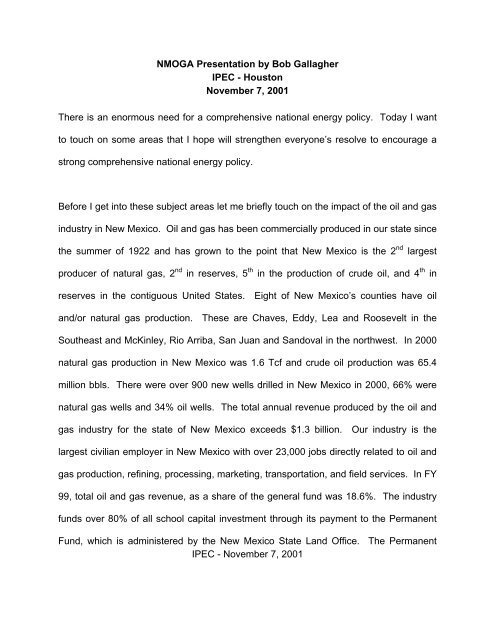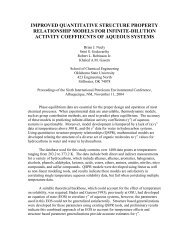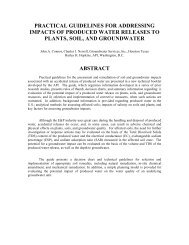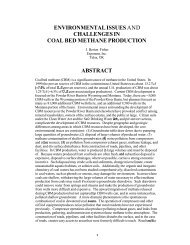NMOGA Presentation by Bob Gallagher (Lunch talk) - IPEC
NMOGA Presentation by Bob Gallagher (Lunch talk) - IPEC
NMOGA Presentation by Bob Gallagher (Lunch talk) - IPEC
Create successful ePaper yourself
Turn your PDF publications into a flip-book with our unique Google optimized e-Paper software.
<strong>NMOGA</strong> <strong>Presentation</strong> <strong>by</strong> <strong>Bob</strong> <strong>Gallagher</strong><strong>IPEC</strong> - HoustonNovember 7, 2001There is an enormous need for a comprehensive national energy policy. Today I wantto touch on some areas that I hope will strengthen everyone’s resolve to encourage astrong comprehensive national energy policy.Before I get into these subject areas let me briefly touch on the impact of the oil and gasindustry in New Mexico. Oil and gas has been commercially produced in our state sincethe summer of 1922 and has grown to the point that New Mexico is the 2 nd largestproducer of natural gas, 2 nd in reserves, 5 th in the production of crude oil, and 4 th inreserves in the contiguous United States. Eight of New Mexico’s counties have oiland/or natural gas production. These are Chaves, Eddy, Lea and Roosevelt in theSoutheast and McKinley, Rio Arriba, San Juan and Sandoval in the northwest. In 2000natural gas production in New Mexico was 1.6 Tcf and crude oil production was 65.4million bbls. There were over 900 new wells drilled in New Mexico in 2000, 66% werenatural gas wells and 34% oil wells. The total annual revenue produced <strong>by</strong> the oil andgas industry for the state of New Mexico exceeds $1.3 billion. Our industry is thelargest civilian employer in New Mexico with over 23,000 jobs directly related to oil andgas production, refining, processing, marketing, transportation, and field services. In FY99, total oil and gas revenue, as a share of the general fund was 18.6%. The industryfunds over 80% of all school capital investment through its payment to the PermanentFund, which is administered <strong>by</strong> the New Mexico State Land Office. The Permanent<strong>IPEC</strong> - November 7, 2001
Funds distributes money to 22 beneficiaries including colleges, vocational institutes, andother public services in every county of New Mexico.15 years ago, my friend Danny Conklin had this to say during his first interview asChairman of IPAA: I hope we will be able to convince Congress that a healthy domesticindustry is an asset, and that we must have a national energy policy for it to be anasset...I hope we can look to the future and develop a game plan that will benefit theindependents and this country...We need to create a business climate that the domesticpetroleum industry can operate under. Whether it be oil or gas, if the climate is there,the exploration for those products will come along. That was 15 years ago, and I’mafraid we have not made much progress.Let me now move briefly to the domestic oil and gas Industry. I believe that thedomestic oil and gas industry is the backbone of our economy and is truly a matter ofnational security.America must develop better policies to enhance and maintaindomestic oil and natural gas exploration and production, we need both. We must beginto treat domestic oil and gas production as a critical element of national economicsecurity. To do this, at the federal level we must direct our efforts at the two areaswhere they will have the greatest effect: access to capital, and access to domesticnatural resources from federally controlled lands and waters. It is important tounderstand that a large aspect of access to natural resources involves opening thatwhich is now not available, and halting the trend of further roadblocks and moratoriums<strong>IPEC</strong> - November 7, 2001
of western lands.Energy Secretary Spencer Abraham last month released a Department of Energy studyshowing that access to nearly 68% of natural gas resources in the Green River Basin inthe Rockies is closed or significantly restricted. From a practical permitting standpointthere is severe limitation to access.We must also deal with permitting limitations and other indirect actions of federalagencies. Because these are federal lands, it is necessary that the federal agenciesissue permits for exploration and production activities. The National EnvironmentalProtection Act or NEPA can be used to create effective, environmentally soundmanagement plans, or it can be used to delay and deny access. The total time for oiland gas drilling, from the first idea until the first well was spudded, averaged 12-36months for federally managed lands, but only 2-4 months for private lands.NEPA is only one of many laws that is involved, add the Endangered Species Act, theClean Water Act, Clean Air Act and the actions of the Fish and Wildlife Service and theEPA and pretty soon you have a grim picture of the future of our industry. The time hascome to put to bed the myth that development and the environment are not compatibleor are diametrically opposed. Our industry has shown we can develop valuable naturalresources while protecting the important wildlife and environmental values that exist, wehave proven that in Prudhoe Bay where the caribou has coexisted with the oil and gas<strong>IPEC</strong> - November 7, 2001
industry for 30 years and has grown from 3,000 animals to 20,000 animals.These federal policies toward government-controlled lands are a linchpin to meetingfuture natural gas demand. They must be modified to assure that the benefits ofsupplying this clean burning essential fuel are fully considered.I propose a simple litmus test: 1) is it based on sound science; 2) does it make commonsense; and 3) is it environmentally sound and sensitive?Each year when a freeze hits the state of Florida we hear the price of grapefruit willincrease significantly because a large amount of the supply was destroyed and as suchdemand will exceed supply. We all accept that reality and move on, so why is it so hardto understand that is exactly where we are today with natural gas, and why we are inthe middle of an “energy challenge.” A second grader will tell you that if anything is inshort supply, make more of it.In many respects, the energy challenge facing the United States is a product of thecountry’s success. The rapid expansion of the U.S. economy, a growing standard ofliving and increasing population have all contributed to an increase in energy demand.Although improvements have been made in energy efficiency, these improvementshave not kept pace with rising energy demand. Contributing to the problem is anoutdated energy infrastructure. Aging power plants, electrical transmission lines,<strong>IPEC</strong> - November 7, 2001
pipelines and refineries are in need of renovation and expansion.The proposed National Energy Policy is based on three basic ideas. These ideasinclude the creation of a long-term energy strategy for the United States, advancingenvironmentally friendly technologies to increase energy supplies and efficiency andraising peoples’ standard of living <strong>by</strong> integrating U.S. energy, environmental andeconomic policies.So, what is a good energy policy? What goals does such a policy pursue, and whatactions make it good?Goals are simple. A proper energy policy pursues security of energy supply in serviceto national economic growth and military defense. That’s all.The oil and gas industry has a role to play in providing solutions. Our goal is to assist inthe development of a reliable, affordable and environmentally sound energy supply forthe Untied States. Key principles of any energy policy should include:$ Environmental Responsibility - Industry believes that any energy policymust be environmentally responsible. A national energy policy shouldempower companies to unleash technical innovation and develop newways to reduce emissions and produce cleaner fuels. Policy should dictate<strong>IPEC</strong> - November 7, 2001
an environmentally positive outcome, but not prescribe the steps orformulas’ companies must use to reach that outcome.$ Diversity of Supply - The U.S. energy security depends on energy froma wide range of sources and locations, both foreign and domestic. Today’seconomy is global and the U.S. energy policy should mirror that reality andencourage global and domestic exploration and production. We should notlet these inevitabilities compromise domestic capacities to produce andprocess hydrocarbons. Good energy policy adapts itself to marketevolution, yet prefers domestic to imported supply for mostly economic andnational security reasons.$ Free Markets - A good energy policy lets the market work and should befirmly rooted in free market principles. It does not interfere with fuel prices,which naturally rise and fall over time. It does not make fuel choices forconsumers or try to influence consumption levels of specific fuels or ofenergy in general. A competitive free market is the quickest and mosteffective way to balance the energy supply and demand equation.The goals of an energy policy do not need the lattice of environmental qualification thatobscures official attention to energy matters these days. The economy has tuned itselfto economic values. Energy initiatives that serve national economic initiatives and<strong>IPEC</strong> - November 7, 2001
comply with a non-obstructionist environmental regulation strike the best possiblebalance between economic reward and environmental risk.Overly zealousenvironmental preservation has lead to a situation that is out of balance with theappropriate principles of multiple use. We comprehend that some circumstancesrightfully prevent oil and gas industry in certain areas, but come on – Florida --Farmington -- southeastern New Mexico and the Aplomado Falcon. These storieswould be funny except that it is continuous. This and many more horror stories deftlyillustrate the wide-range issues that federal lessees wrangle with every single day.There is no end to the foot dragging, delays, threats, overly restrictive stipulations andconditions of approval, loss of revenues, absence of decision-making, unreasonabledemands, uncertainty, and lack of administration. Industry is frustrated, discouraged,and beginning to look elsewhere to produce oil and gas. Witness the major oilcompanies that have sold virtually all of their onshore properties and moved offshoreoverseas to explore for and produce oil and gas. It is simply too expensive, timeconsumingand difficult to operate on federal lands in the United States.The federal government must make federal lands available for oil, gas and coal leasing.Undeveloped resources contribute nothing to energy supply and nothing to state,regional and national economics. We must treat refining as an essential element ofsupply security. Because crude oil has little value as an energy source until it is refined,the ability of refiners to process crude oil into products required in the U.S. marketshould receive priority. Because of environmental mandates, costs and obstructions, a<strong>IPEC</strong> - November 7, 2001
new refinery has not been constructed in the U.S. in the past 25 years. Energy andenvironmental policies should complement and accommodate one another. Theheretofore under acknowledged reality is that they can.Still wondering why we need and energy policy? Let’s take a global look. Progress oninternational trade has seldom been more important than it is in the confused aftermathof the September 11 terrorist attacks in New York, Washington, DC, and Pennsylvania.The attacks aggravated a worldwide economic slowdown. Evidence builds that theworld is in recession. In response to the attacks, the US, the UK, and other allies havebegun what promises to be a long and expensive war. Prompt economic recovery iscrucial to that effort.At this moment, nothing would be better for the US and worldwide economies thanstrong international action on behalf of trade. The war on terrorism thus should giveeconomic priorities new urgency and dissipate the fog that surrounded trade issuesbefore September 11.The overarching goal, given new focus <strong>by</strong> the war against a demonstrated global threat,must be restoration of economic health. The arguments shouldn’t be about whethertrade should increase; they should be about how to make the increase occur. And theUS, as the leader of the war on terrorism, should invigorate its leadership of thisdiscussion.<strong>IPEC</strong> - November 7, 2001
Action on energy can strengthen or weaken US leverage in that crucial role. US energypolicy demonstrates US commitment to economic growth. It’s that simple. If the USgovernment wants governments of other countries to behave responsibly on trade insupport of global economic health, it should behave responsibly on energy in support ofthe US economy.In US energy politics, of course, the central issue is leasing of the Arctic NationalWildlife Refuge coastal plain. The policy reality is that Congress can do much toimprove US energy conditions without approving ANWR leasing. For starters, it canand should fix taxation and other impediments to domestic production of oil and gas.It should also, however, approve oil and gas leasing of the ANWR coastal plain – andnot just because of the potential energy supply. Beyond its great geologic promise,ANWR symbolizes the US approach to development of natural resources. Until now,the federal government has allowed environmentalism increasingly to blockdevelopment -- not just in ANWR and not just of hydrocarbon resources. Too often, theobstructionism grounds itself in environmentalist exaggeration – and in ANWR’s caseoutright lies. It dominates policy-making nevertheless. And <strong>by</strong> limiting development ofnatural resources, it limits economic growth.<strong>IPEC</strong> - November 7, 2001
With ANWR, there is no sound environmental case against leasing and drilling of therelatively tiny area of industry interest. That area is not pristine, as leasing opponentsclaim. The industry can drill and produce there without causing significant or lastingdamage. Yet the resource lies unevaluated, the tremendous economic potentialthought to exist there unrealized in deference to an environmental agenda thatmeasures success in terms of the economic activity it prevents.Well, it is time to ask the question: Is the US serious enough about economic growth toadjust this self-sacrificial political formula, or is it not?Terrorist attacks are a very real threat to US energy infrastructure. Efforts to protectcritical infrastructure should be given real priority and the US government should help oiland gas companies take protective measures.Given that terrorists have already shown the ability to turn our economic infrastructureinto weapons to be used against the American people, we should take the threat ofenergy infrastructure terrorism seriously.While the risk to most energy infrastructure can be dealt with adequately, attacks onsome components could be far-reaching, causing serious disruptions locally, regionally,or even nationally. There could be widespread suffering and environmental damage,depending on the scale of any such attacks.<strong>IPEC</strong> - November 7, 2001
Analyzing the threat to the 800-mile Trans-Alaska Pipeline, which ships oil from theNorth Slope, the serious damage to the line would have a major impact on the USeconomy and energy supply. It has been noted that a single gunshot in October caused285,000 gallons of crude to spill. Shut it down with a bomb and we have a real energycrisis, particularly in California.Also, any shutdown of a major interstate natural gas pipeline supplying California wouldhave a significant impact. The impact could be particularly severe if there were acoordinated series of pipeline attacks.An attack on an oil tanker at a major terminal could easily shut a port down and disruptenergy flows, jobs and the movement of goods. Despite advances in safety, oil tankersare not designed to withstand even a rudimentary terrorist attack.As for refineries, a terrorist attack could turn the facility itself into a weapon of massdestruction. The release of hazardous materials following an attack would affectsurrounding areas muck like a chemical weapon attack.The government should provide incentives, such as tax credits and low-cost financing,for companies to strengthen critical infrastructure against attack.<strong>IPEC</strong> - November 7, 2001
Since August the gas rig count has fallen from 1,060 to 876. This boom-bust cycleresults in wild and harmful price volatility. The last 22 months are an example. In thatperiod prices have increased 350% - from $2.40/mcf to $9.00/mcf - and fallen again to$2.40/mcf. In the last ten days it has ranged from $2.33 to $3.10 where it currentlystands.Without proper drilling incentives, we are in for more of the same for the next 6-10years, where there is hope for a new pipeline to the Alaskan North Slope to bring in asignificant new source of supply.Volatile natural gas prices disrupt the economy creating uncertainty for industrial,commercial and residential users. The new and important wrinkle is that the disruptionwill be substantially greater than in the past. In the past, gas price volatility affectedprimarily industrial and commercial users who used gas as a boiler fuel, or residentialusers who used it to heat their homes. In the future, in addition to these sectors, thevolatility will feed through the electricity grid into every corner of economic activity.Electricity generation is increasingly dependent on natural gas as a primary fuel. Inturn, the entire economy is increasingly dependent on electricity as an energy source.Of new generation planned for the next seven years, approximately 85% is expected tobe gas fired. Gas fired generators will increase from 14% to approximately 31% of thenation’s generating facilities. Twenty-two gigawatts of new gas-fired generating<strong>IPEC</strong> - November 7, 2001
capacity was added in 2000 (an 18% increase from the 1999 level). Forty gigawatts ofgas-fired capacity are estimated <strong>by</strong> various sources to be added in each year of 2001and 2002.In closing, if we are to provide the country with the domestic energy it deserves, weneed to create national policies that allow environmentally sound development of theseresources. No one can expect to climb out of this “energy challenge” overnight, it tookus 20 years to get here, but we need to start the process. We cannot conserve our wayout of this “energy challenge.”A balanced approach of conservation measures,increased exploration, production and access to government controlled lands coupledwith additional refinery capacity and new technological advancements will go a long waytoward providing a reliable, affordable and environmentally sound energy supply for theUnited States.<strong>IPEC</strong> - November 7, 2001
















